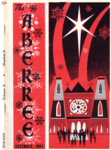Volume 10, Issue 8, page 5
W
W
a
04
5
VAGARIES
of the
c~I~SZ1S
By Prof. HILTON HOTEMA
CAREFUL examination of the Bible
for definite evidence as to the existence of the Gospel Jesus discloses none. On the contrary, much
appears to indicate to an open, unprejudiced mind that this Jesus is
fiction. Just as Santa Claus is a fictitious personality invented to entertain
children, so Jesus is a similar character
fabricated to entertain -- and control --
adults.
All the evidence the world has to the
existence of Jesus appears in the four
Gospels of the New Testament. They cover
approximately 50 hours of his alleged
life -- slightly more than two days.
In the New Testament there are 21 Epistles,
14 of which are attributed to Paul (Poi,Polos,
Apollonius, the great Pythagorean philosopher
of the First Century.)
The authors of these Epistles, which are
the earliest of the New Testament books, and
the authors of the second and the fourth of
the four Canonical Gospels, make no mention of
a virgin birth. The first and the third of the
four Gospels are the only authorities for the
virgin birth, and evidence shows they were not
written until about the middle of the first
half of the Second Century.
Some of the "apocryphal" Gospels contain
the story in even greater detail than the canonical accounts. But most of these Gospels are
also late, and are so filled with miracles, or
otherwise so incredible, that even the miracle-loving framers of the canon rejected than.
And so, for the first time, more than 100
years after the date assigned as the birth of
Jesus and nearly a century after the date assigned to his death, there appears the first
mention of the virgin birth -- a dogma which the
Mother Church subsequently made orthodox, and
w a belief in which most Christian churches to
this day, still insist on treating as a test
E., for orthodoxy, in spite of the fact that the
majority of educated modern opinion opposes it.
Ancient history recovered in recent years
shows the story of the virgin birth was a common
account of the birth of "gods" who had come to
earth as men, and the details related in Matthew and Luke do not differ from those given
in the stories of older cults in any greater
degree than the details in one work of fiction
differ from those in another which treats of
the same theme.
Later in early Christian history, we find
that the Virgin mary inherited the festival of
Cybele, Great Mother of the Gods, the history
of her worship in Rome covering 600 years from
204 B.C. until 394 A. D., when it was outlawed
by the Roman emperor so Christianity would not
he harassed by this ancient competitor.
The Pantheon at Rome, which had been dedicated by Agrippa to Cybele, was rededicated as
a Christian edifice to the Virgin Mary when
Christianity became the state religion, and
the ancient ceremonies connected with the worship of Cybele were transferred to Virgin Mary.
Matthew begins with the genealogy of Jesus,
showing his descent -- the alleged expected descent of the Messiah who would, according to
biblical interpretations of the "prophets",
resuscitate the ancient glories of "Israel" as
a conquering king -- thru Solomon and David (by
the wife of Uriah the Hittite) and Jacob and
Isaac and Abraham.
It is well to state here that the 12 Tribes
of Israel were simply zodiacal in character. A
reading of the 49th chapter of Genesis could
leave little doubt on that score, and all doubt
would surely be removed by reading the opinion
of the 12 Tribes held by the author of the
Apocalypse.
The genealogy mentioned must have been in
existence before the virgin birth story was
ever thought of, for, if the latter be true,
the genealogy is worthless. Unless Joseph was
the father of Jesus, there could be no point
in tracing the pedigree of Joseph; and if Joseph was the father of Jesus, the virgin birth
story is false. If Joseph were only the husband of Mary and not the father of Jesus, the
genealogy has no value nor meaning as an account of the generation of Jesus; and Jesus is
not shown to be "the son of David", as is insisted upon in the Gospel. ,
Verse 16 of Matthew has evidently been altered to suit the new doctrine of the virgin
birth; and that this was the case is made all
the more certain by the fact that in many old
manuscriptic versions of Matthew, it actually
is said that "Joseph begat Jesus". In what is


